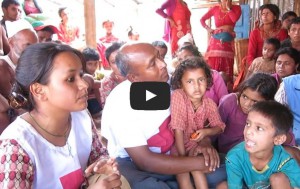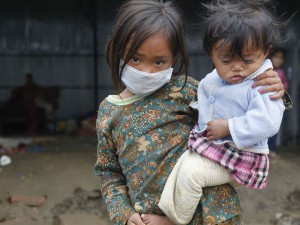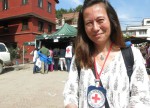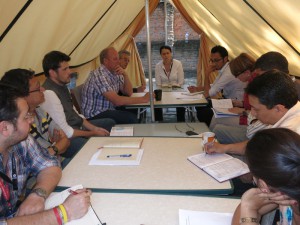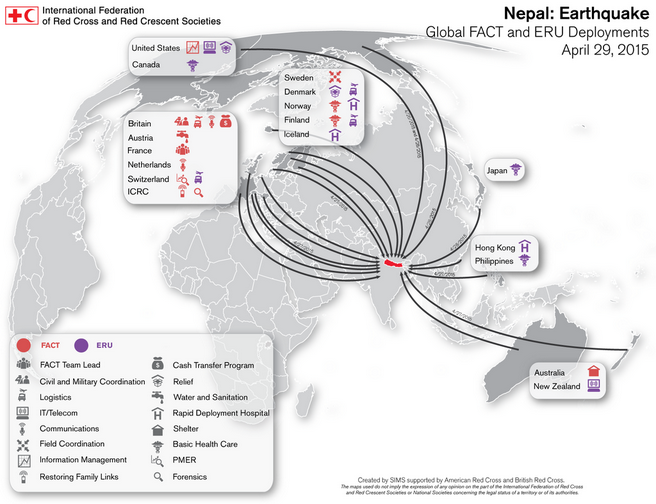Psychosocial Support Helps Dispel Fears of Communities in Nepal
Psychosocial first-aid counselors of the Nepal Red Cross Society supported by the International Committee of the Red Cross (ICRC) have been visiting the quake-affected communities to relieve the trauma and fear of the people and to help them move on with their lives.
Thousands of homes and civic infrastructure buildings have been destroyed. Fourteen of the 75 districts in Nepal have been worst affected and the aftershocks have not stopped.
25 May, 2015
They Fondly Call Him ‘Ambulance Uncle’
Narayan Kumar Shrestha is today lovingly known as the ‘Ambulance Uncle’. Of the 200 people seriously injured and flown in to Dhading, more than half were carried on the back by ‘Ambulance Uncle’.
Taking inspiration from his work and dedication, hundreds of youth have joined the Red Cross as volunteers. An executive member of the Red Cross Chapter of Dhading, Shrestha rescued over 100 people affected by the quakes on 25 April and 12 May at Nilkantha Municipality in Dhading district.
18 May, 2015
Between 25 April and 16 May 2015, in cooperation with the NRCS, the ICRC:
- enabled 565 persons inform they were alive through the familylinks website; visited 19 hospitals, 11 camps for displaced people, two children homes as well as 10 jails, in order to offer contact with the families, collect lists of missing persons and assist those who could not return home by themselves; sent teams to some of the most heavily affected districts, namely Sindhupalchok, Gorkha, Rasuwa, Dhading and Nuwakot to assess needs in terms of restoring family links; provided tarpaulins and hygiene kits to ten jails, and notified embassies of foreign detainees of their fate;
- helped the NRCS kick start basic psychological support to earthquake survivors in five districts, namely Sindupalchok, Dhading, Gorkha, Nuwakot and Rasuwa; opened child friendly spaces in Nuwakot, Dhading and Gorkha;
- supplied hospitals in the Kathmandu Valley and outlying districts with nine sets of dressing modules, eight sets of plaster castings as well as with tarpaulins; provided support to NRCS for its first aid services;
- worked with its partners at Green Pastures Hospital, Pokhara, and Yerahiti Rehabilitation Centre, Kathmandu, to plan for the long-term physical rehabilitation of earthquake victims;
- handed over 2,000 body bags to the NRCS and to hospitals; fulfilled all needs related to personal protective equipment for the Department of Forensic Medicine and will provide them with additional refrigeration capacity to properly manage the dead.
14 May, 2015
Nepal suffered another massive jolt on 12 May. Over a hundred were reportedly killed and more than one thousand people injured in the recent earthquake. While strong tremors have continued since 25 April, the earthquake that struck on 12 May is estimated at 7.3 on Richter’s scale. With its epicenter in Dolakha, this severe jolt caused destruction, and generated fear and anxiety in the already traumatized Himalayan country.
“This latest earthquake was almost as strong as the last one and caused a huge amount of fear and panic,” said Laetitia Courtois, ICRC’s deputy head of operations for South Asia.
According to statistics provided by Nepali authorities, on 13 May, there were about 8,200 deaths and 17,800 injuries, while over 7,941 bodies have been handed over to the respective relatives.
Since the 25 April earthquake, the ICRC delegation in Nepal has been supporting the Nepal Red Cross Society (NRCS) in its response to the escalating needs of families and communities. The ICRC has deployed a specialist who is part of the Field Assessment Coordination Team (FACT) to help in the restoration of links between family members affected by the disaster and so far, 44 volunteers from 13 districts have been mobilized by the NRCS to help undertake this task. Teams have visited 19 hospitals, 11 camps for those displaced and two children’s homes in order to put families back in touch with each other.
6 May, 2015
Ensuring Families are able to Perform Last Rites for their Loved Ones
Shuala Drawdy, an ICRC Forensics expert, has been deployed to Nepal to help with our response as part of the International Red Cross and Red Crescent Movement’s assistance to communities in the aftermath of the earthquake.
In this interview she talks about the current situation in Nepal and explains why there is a special need for expert advice to handle the mortal remains of victims of a disaster.
5 May, 2015
ICRC Head of South Asia Region in Nepal to Strengthen Red Cross Movement’s Response
Anthony Dalziel (fourth from left), Head of SOUC Region, ICRC; Alfredo Mallet (Deputy Head of Delegation, ICRC Kathmandu) and Dragana Kojic (Head of Delegation) with other ICRC colleagues at the daily Nepal Earthquake crisis-management meeting in Kathmandu. Anthony is in Nepal to strengthen the Red Cross Movement’s response to the earthquake.
Red Cross Movement Steps Up Relief Effort
The impact of the earthquake on Sindhupalchok is massive, with the number of the dead in the hundreds, while recovery operations are on-going still. The disaster affected a significant number of houses and health facilities and equally damaged most of the equipment and devices in affected hospitals.
It will take some time for this to reach most of those affected, given the scale of the impact. The Red Cross relief teams have to contend with a lack of access roads to many affected districts, lack of water and lack of power supply. efforts are being stepped up to respond to the needs of many.
1 May, 2015
Red Cross Mobilises More Relief for Nepal
The number of lives lost as a result of the Nepal Earthquake has crossed 6,000 with millions of others severely affected. According to reports, half a million tents are urgently needed for the large number of people forced out of their homes due to the devastation apart from other help for the affected.
An emergency control room has been set up for continuous monitoring of the situation and mobilizing help as more needs of the affected population are assessed. While a large water purification unit, 500 body bags and 100 stretchers have already been sent, the next batch of relief being prepared will include another large water purification unit, 800 family tents, 2000 tarpaulin sheets, and 2000 woolen blankets. The International Federation of the Red Cross and Red Crescent Societies (IFRC), the International Committee of the Red Cross (ICRC) and other partners have pledged their support in the form of providing trained manpower and materials to the Indian Red Cross Society.
29 April, 2015
Urgent Press Information on Missing Persons in Nepal
New Delhi (ICRC) – Following the earthquake that occurred in Nepal on 25 April 2015, the International Committee of the Red Cross (ICRC) has activated its tracing mechanism to enable it find those separated from their loved ones by the disaster.
Its web service dedicated to this activity is http://familylinks.icrc.org/nepal-earthquake/. It is both in English and Nepali languages. This website makes it possible to:
Search through the list of missing persons and of those people who have responded that they are alive
Register names of persons who wish to inform others that they are alive
Register names of persons with whom they have lost contact
On the provision of these information, the Red Cross Movement will endeavor to locate those registered as missing and post the results on the website.
28 April, 2015
Situation as at 28 April – Update from the Nepal Red Cross
Volunteers of the Nepal Red Cross Society (NRCS) continue to work round the clock in extending first aid, transporting the wounded to hospitals, supporting search and rescue efforts, providing temporary shelter and other humanitarian services to the affected. These humanitarian services are being implemented in coordination and cooperation with the Government of Nepal, UN agencies, International Red Cross movement partners and the communities.
More than 1400 have been provided with first aid services. A total of 3700 tarpaulin and 500 blankets have been distributed. WASH items, including 1500 bars of soap, 6300 water purification tablets and 5000 of Oral Rehydration Solution (ORS) have been distributed in Bhaktapur. Outside the capital, the Red Cross has dispatched 2500 sets of relief materials to severely affected district chapters. The Red Cross has deployed National Disaster Rescue Team (NDRT) in the 12 worst affected districts. The Red Cross district chapters have reported that 33 districts are affected.
The Red Cross District branches say more than 200 have gone missing, over 500,000 displaced and at least 40 thousand houses brought to ruins.
27 April, 2015
Red Cross Relief Supplies being Flown to Kathmandu
More than 4,000 people were reported to have been killed by the evening of 28 April. The IRCS was asked by the Indian Government for support by providing a large water purification machine with capacity of delivering 3,000 litres of clean drinking water per hour, along with trained personnel. The IRCS was also requested to provide 100 stretchers.
The equipment, accompanied by three trained personnel, were flown to Kathmandu in one of the aircraft provided by the Indian authorities. Five hundred body bags required to manage the mortal remains of victims have been provided by the International Committee of the Red Cross (ICRC) and are also in the process of being sent to the Nepal Red Cross Society (NRCS).
An emergency control room has been set up at the IRCS National Headquarters.
26 April, 2015
Red Cross Movement’s Frontline Response & Efforts to Restore Contact between People
Over 2500 people have been reported dead since Saturday morning when the 7.9 magnitude earthquake hit the area between Kathmandu, the capital, and the city of Pokhara. As Nepal grapples with the devastation caused by one of the worst earthquakes in its recent history, the International Federation of the Red Cross and Red Crescent Societies (IFRC) prepares to mount an emergency response operation.


